So here you are, scratching your head, wondering how to manage the schedule of your project.
Maybe you’re a freelancer trying to schedule client work. Or perhaps you’re a project manager who needs a quick reminder on the different project scheduling techniques. Whatever the case, we’ve got your back.
In this guide, we’ll show you exactly what schedule management is, why schedule management is so important for project managers, how to manage a master schedule, and different methods for effective project scheduling. To make your life even easier, we’ll also show you how to use software to maximize productivity and reduce risk of error.
Get startedWhat is schedule management in project management
Schedule management in project management is the process of planning, developing, controlling, and monitoring a project timeline to make sure that tasks and activities are completed on time.
Here’s an example to illustrate. Imagine you’re a project manager, and you’re managing a team that’s organizing a high-profile music festival.
Precision timing is key – you need to make sure the artists arrive on time and perform on schedule, all your vendors are ready, and security is in place when you need them. You might also run into a few issues – the sound equipment truck is delayed, an artist can’t make it and you need a last-minute substitution, and so on.
With effective schedule management, you’ll adeptly navigate these hurdles, making necessary adjustments to maintain a seamless festival experience, culminating in a successful and memorable event.
What is a project schedule?
The main tool for schedule management is a project schedule. A project schedule is a detailed timeline that outlines the tasks, activities, and milestones required to complete a project. It helps you plan, track and manage your project resources and activities to ensure that you get your project finished on time.
Project schedules are commonly presented in the form of a Gantt chart, but we can also find them in many other formats (we’ll cover some of them a bit later).
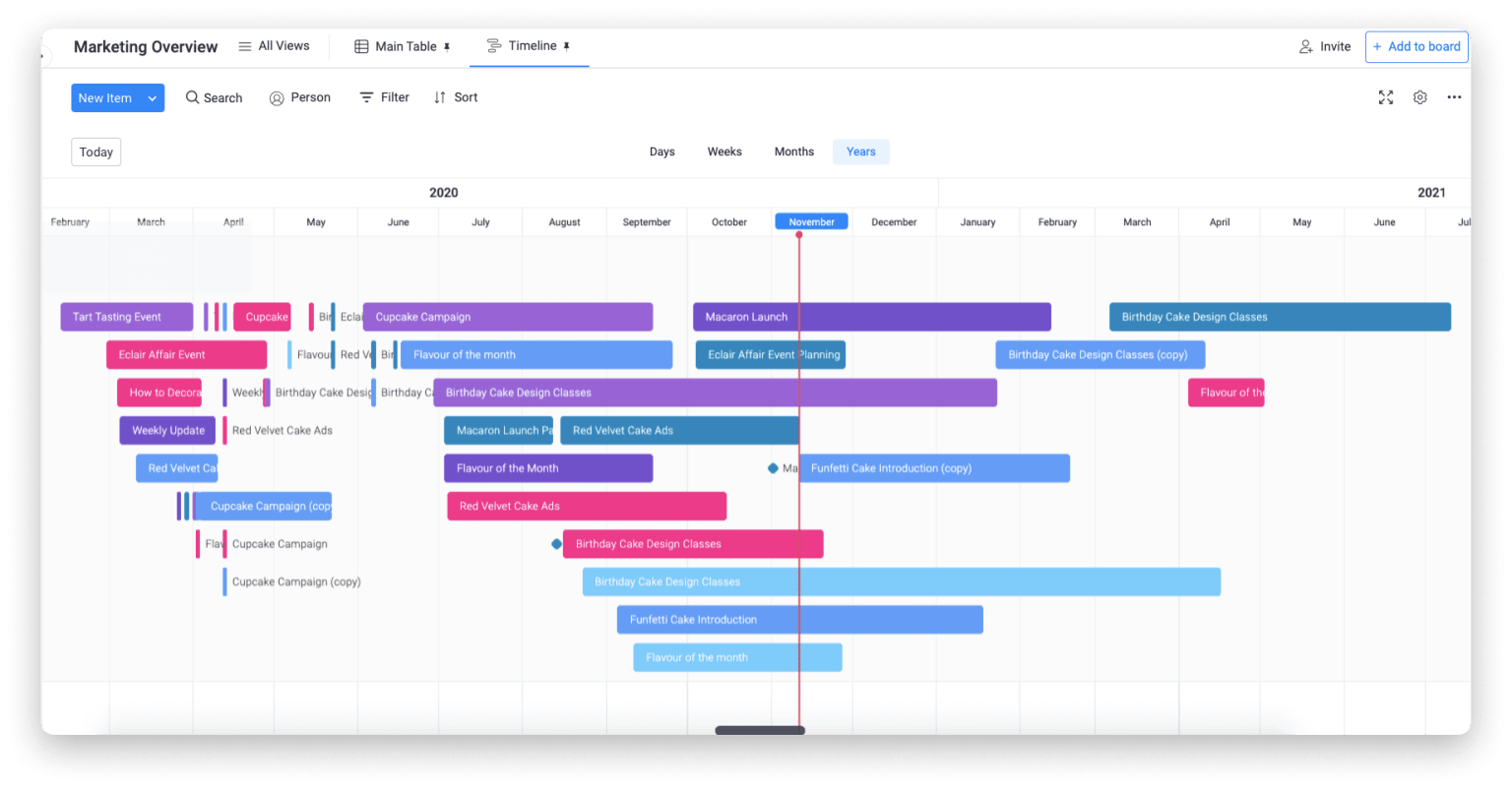
How to create a project schedule
1. Define the project scope
A project scope is a detailed list of exactly what the project includes (and what it does not) — all the deliverables, tasks, technical requirements, and client expectations. You can’t begin to create a project schedule until you know precisely what the project entails, so you can work out how long it’s going to take.
2. Create a task list
Next, you’ll need to break down the project into smaller tasks that can be assigned to the project team. You can do this within your project management software to make this process as simple as possible. monday.com AI assistant can even do this for you automatically — just write your overall goal and it will suggest tasks you should include in your task list.
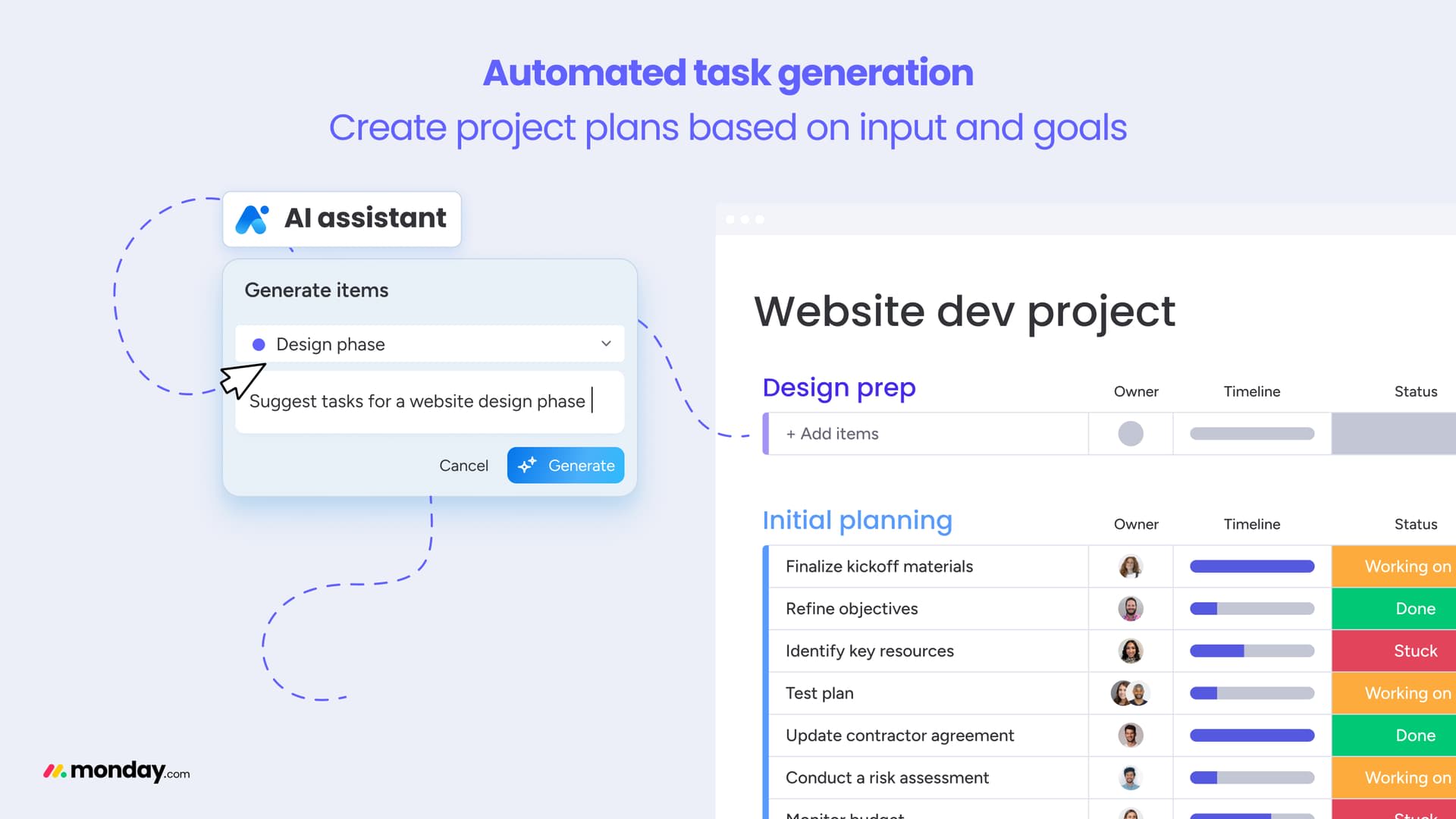
3. Identify task dependencies
Task dependencies are the logical relationships between tasks. For example, imagine you’re planning a construction project. You’d need to excavate the site you wanted to build on before you can pour the foundations. So, the task “Foundation Pour” would depend on the completion of the task “Site Excavation.” That’s a task dependency — and you’ll need to take it into account when you’re creating your project schedule.
4. Set project milestones
For most projects, it makes sense to add additional checkpoints (called project milestones) along the way to your final deadline. This will help you spot and address any delays promptly.
5. Assign tasks
Distribute your task list across your project team, bearing in mind the individual capacity and abilities of each team member. With monday work management you can use the Workload View to keep an eye on the workload of your team, making sure nobody ends up with too much on their plate.

6. Monitor and evaluate the schedule
Now you’ve got a schedule set up, but it’s crucial to keep a close eye on progress. After all, when it comes to project management, it’s always best to expect the unexpected. The roadmap dashboard on monday.com is a good way to take a bird’s eye view of your project and make sure you’re still on track.
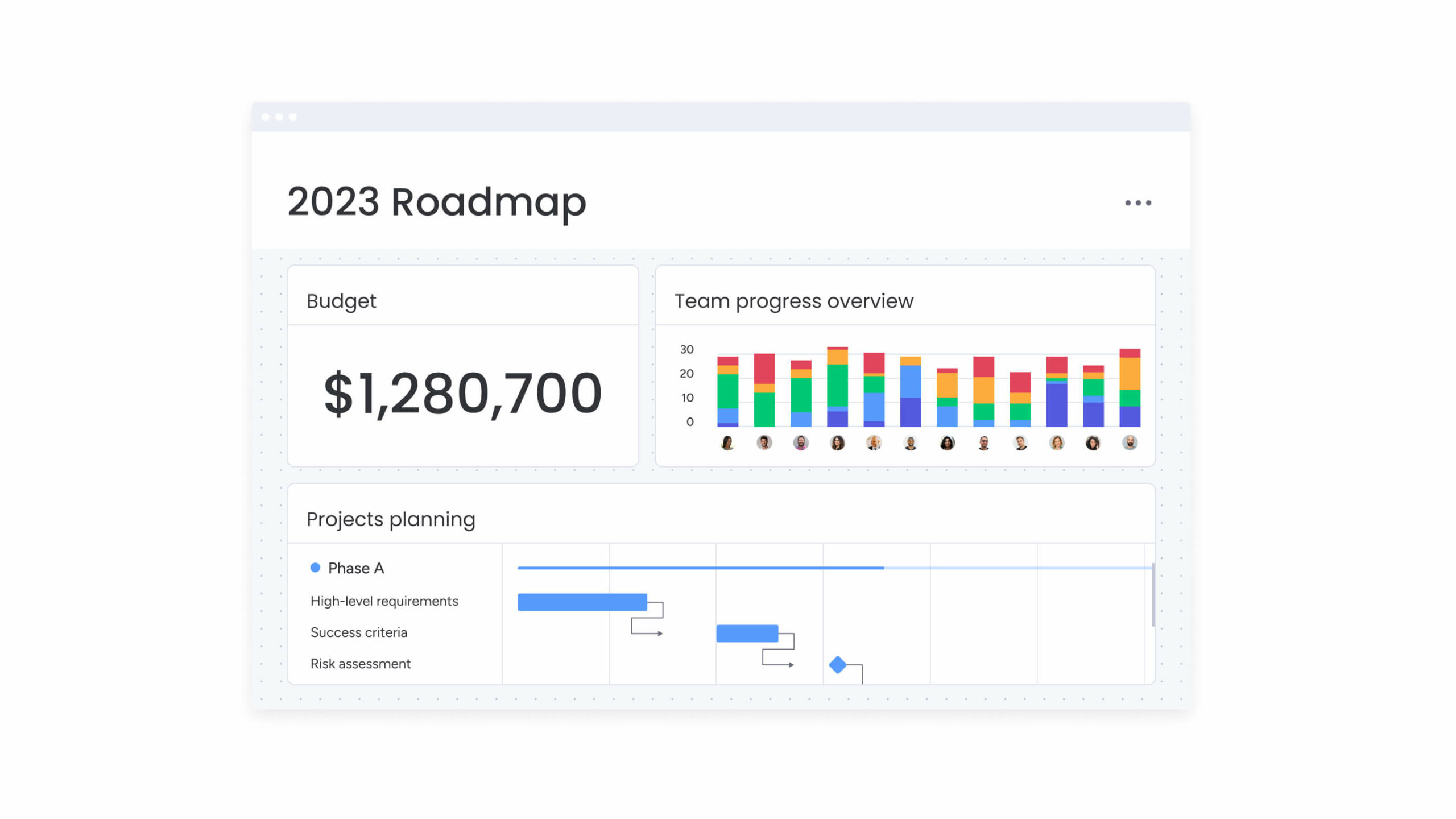
If you’d like a more detailed guide to creating a project schedule, check out: How to create a project schedule in 6 easy steps.
The importance of effective schedule management
Nearly 40% of projects don’t complete a robust planning process, yet planning is the 3rd most valuable project process.
Schedule management helps you stay on track throughout the project lifecycle and avoid potential issues.
Besides, scheduling activities helps you identify dependencies — the logical relationships between tasks. Without task dependencies, you can’t possibly prioritize activities in the right order.
For example, let’s say you want to make a panini sandwich.
In that case, you could break the steps down into:
- Slice the bread
- Smear mustard on the bread
- Stack up the meat and cheese
- Add your veggies
- Put it all together
In this example, you couldn’t smear mustard on the bread before actually slicing the bread, right?
So the task “smearing mustard” is dependent on the task “slicing bread.” Task dependencies help you build a logical order for all of the activities involved in your project. Without a project schedule, identifying these dependencies will be hard.
monday.com can make schedule management easier. Check it out today!
Get startedKey components of project schedule management
Every project is different, but your schedule management process will likely include:
- Activity Definition: Figuring out the specific tasks and activities required to complete the project. You’ll need to deeply understand the project objectives and scope first.
- Activity Sequencing: Understanding which activities can be done at the same time, which must be done in a particular order, and which ones are dependent on other tasks to be done first.
- Activity Duration Estimation: Estimating the time it will take to complete each task. if you have data from previous projects, then great – if not, you may have to use your expert judgment here.
- Schedule Development: Creating a new project schedule that includes everything you’re going to do, the order you’ll do them in, and how long each step will take. The first version is sometimes called the schedule baseline – the “official” version of the project schedule that you can then use to refer to as you go along. Of course, it’s likely to change as tasks are completed faster or slower than expected.
- Schedule Monitoring: Tracking your project’s progress against the schedule baseline, and comparing what’s actually happening with what you expected.
- Change Management: Making sure that any modifications to the schedule are reviewed, approved, and communicated to the team and the rest of your project stakeholders.
3 methodologies for creating a project schedule management plan
Developing a project schedule management plan will involve putting all your project activities in sequence, and estimating how long each one will take. Figuring out a solid project schedule can be tricky, especially if your project is complex with a lot of dependencies.
There are actually a few different methods you can use. Here are a few of the most common ones:
1. Critical Path Method (CPM)
The critical path method is a scheduling methodology that helps you determine the most efficient path possible for your project — a strong way to understand the logic behind your tasks and calculate the duration of each.
To implement this method, create a list of all the project activities involved. Then, build a sequence of activities considering all the critical dependencies associated with the project. Based on this sequence, you’ll then draw what’s called a “network diagram” — a graphical representation of your project’s workflow.
A network diagram looks something like this:
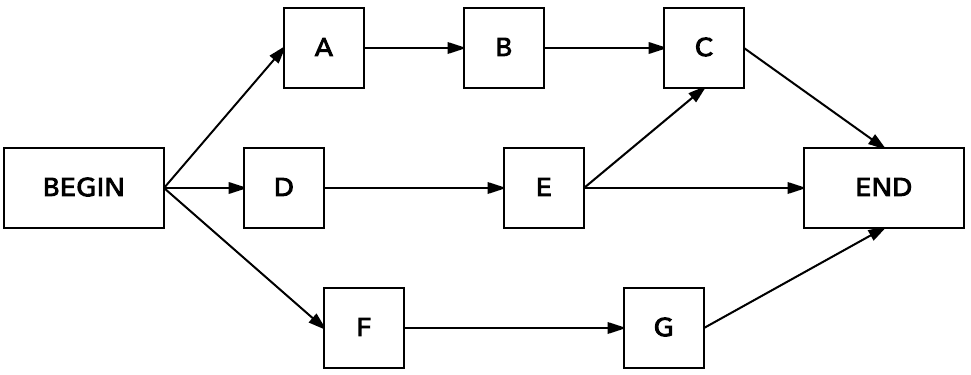
Once you’re done building this diagram, you should estimate individual activity duration. Finally, find your critical path — the best path to complete your project.
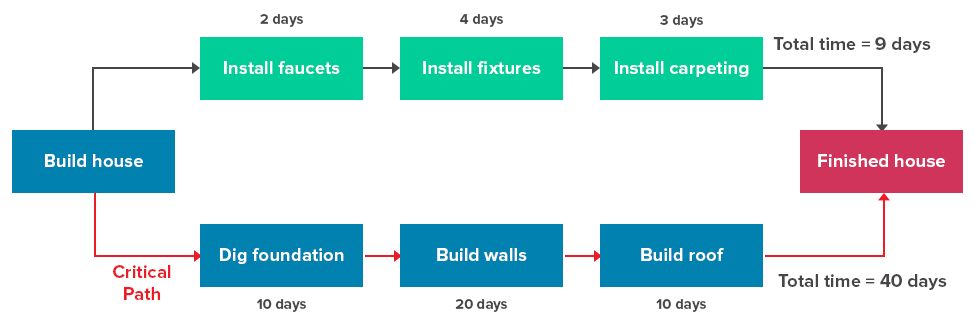
2. PERT
PERT stands for Program Evaluation and Review Technique. The main difference between PERT and CPM lies in their approach for time estimation. While CPM focuses on one-time estimates, PERT uses three-point estimates for every duration:
- Most likely duration: All other things being equal, this is the best estimate for your tasks or projects.
- Pessimistic estimate: The longest time you think a task will take.
- Optimistic estimate: The fastest duration of a specific task or project.
Based on these estimates, you can forecast an average duration for the whole project.
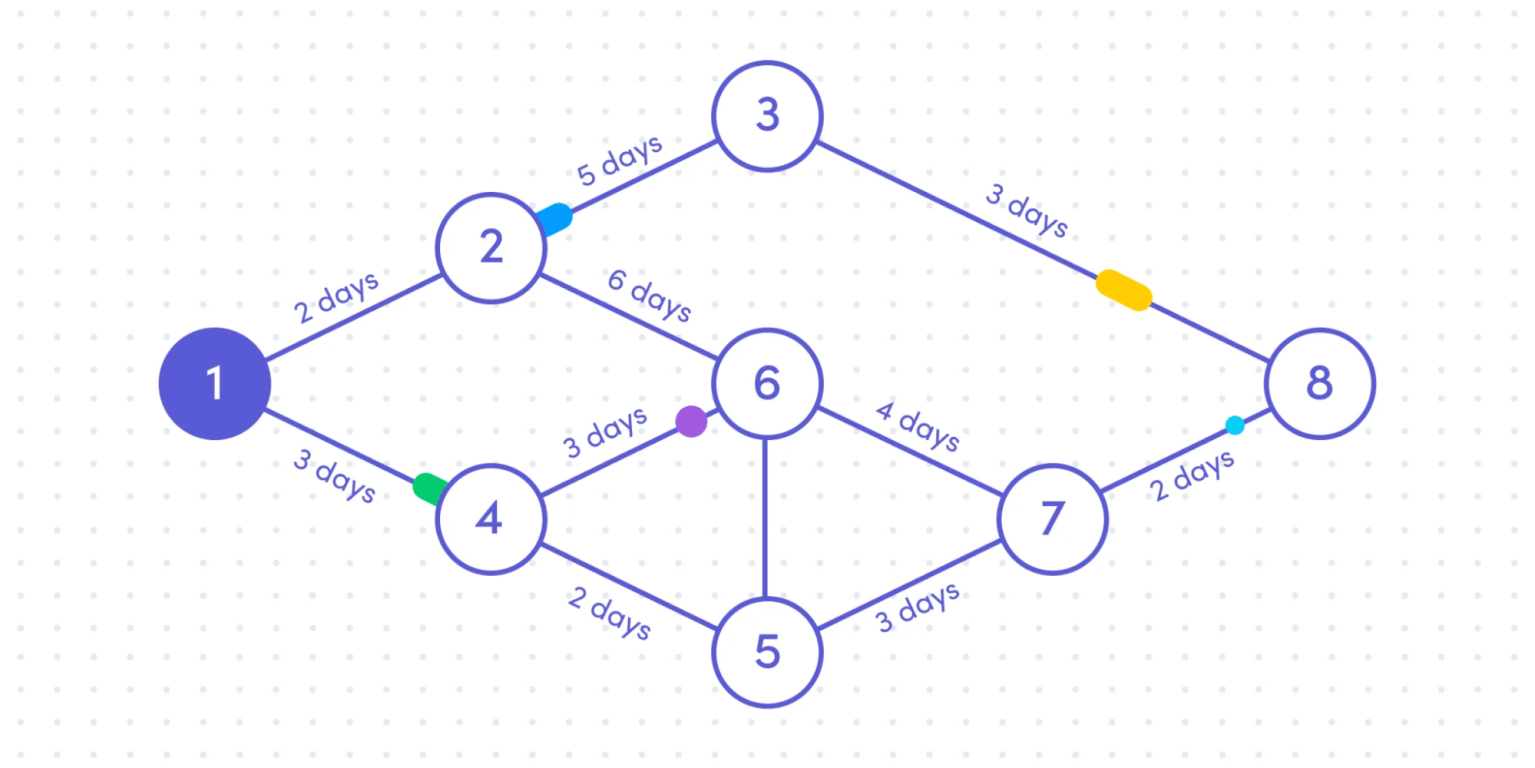
3. Gantt chart
Gantt charts are one of the most popular tools for project scheduling. Here’s what a typical Gantt chart looks like:
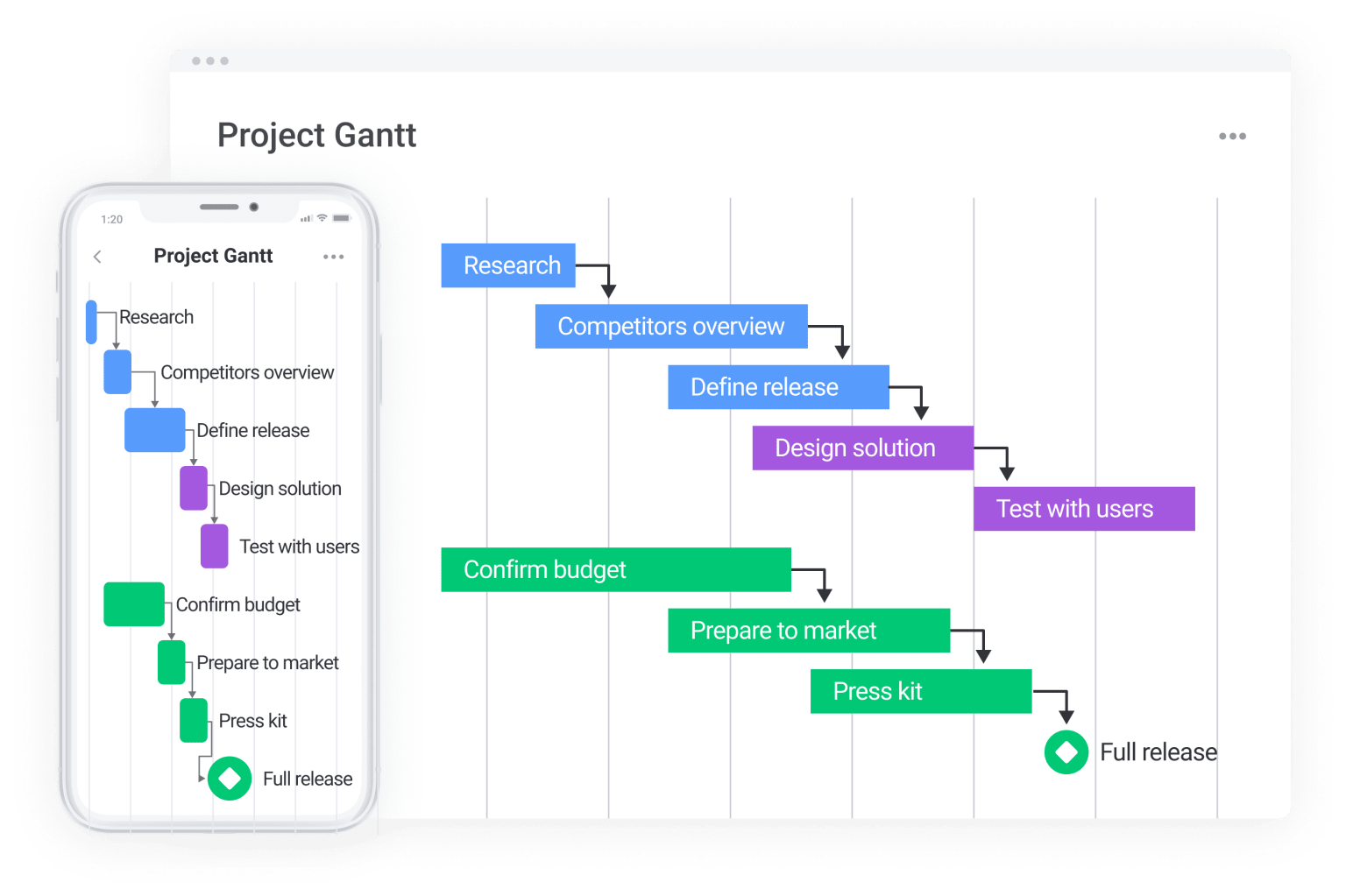
The length of these bars represents the scope of each task and their positioning on the chart represents how they’re scheduled — a simple way to see dependencies between tasks at a glance. You can also run different workflows in parallel, like this:
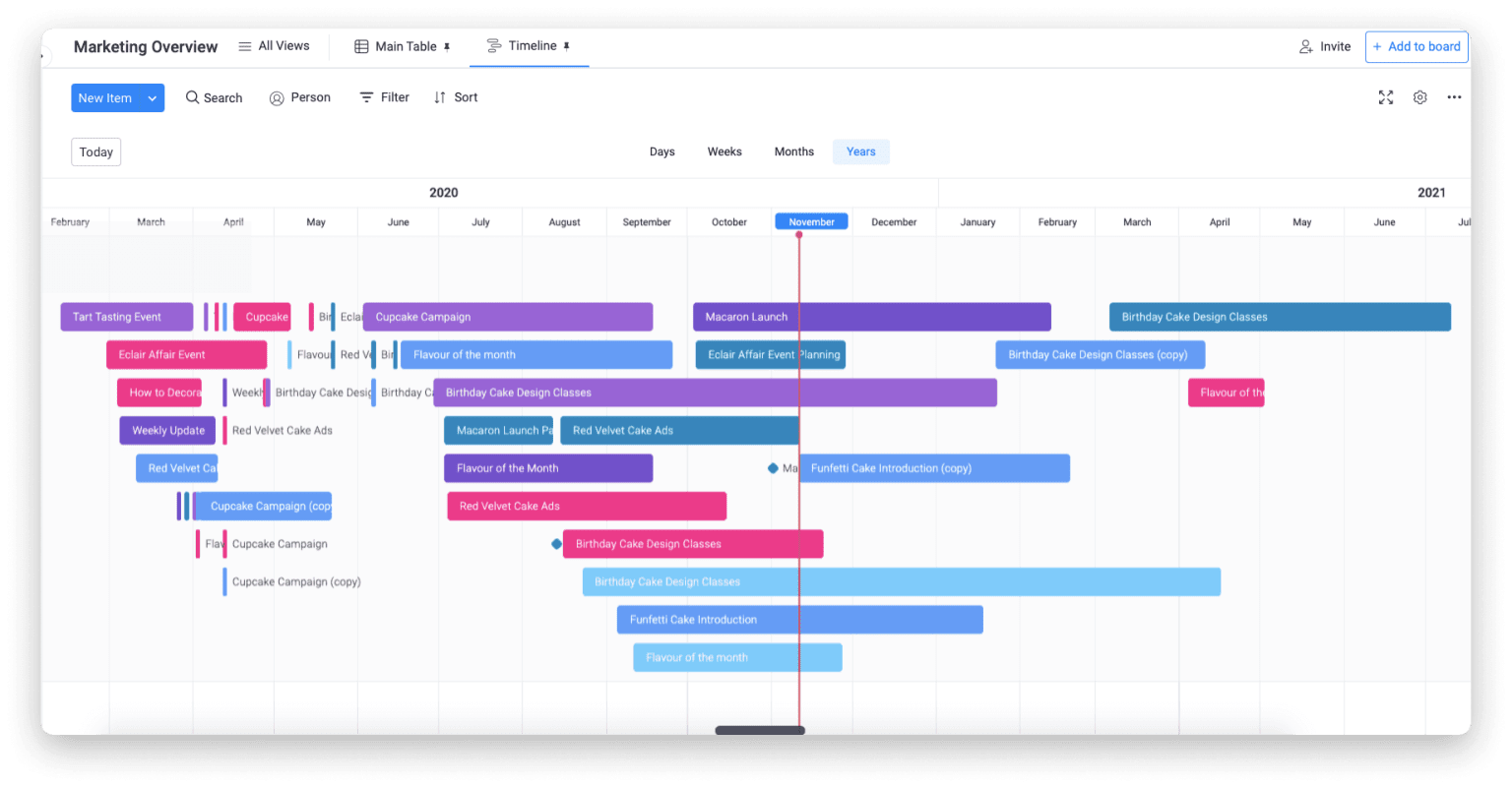
The little diamonds across the chart represent your project milestones. Gantt charts also use a vertical line to indicate the current date, so at any point along the way you can easily understand whether you’re on track and adjust your strategy accordingly.
Pro tip: want to create better Gantt charts? Check out our list of the top Gantt chart software.
Techniques for estimating project durations
In addition to the PERT approach we looked at in the previous section, there are a few other ways you can work out how long each task will take:
Using expert judgment: One of the most common ways to figure out your duration estimates is just to ask an expert. For instance, if you’re building a software application, then a senior software developer will usually have a pretty good idea of how long it could take the team to complete the project.
Analogous Estimating: You can use historical data from projects you’ve done before as a reference. For instance, if you’re working on a new construction project, you could base your estimates off the time each task took you before.
Parametric Estimating: You can use mathematical models to estimate durations, based on specific project parameters. For instance, if you know how long it takes your team to create a single line of code, then you can use that number as a parameter to calculate the amount of time it would take them to write the code for a new feature.
Bottom-Up Estimating: It’s often easier to make an accurate estimate if you break down large tasks into small component tasks, and then add up the times to give you an overall duration. For instance, it’s more straightforward to estimate how long it would take you to build one wall than it would be to estimate how long it would take to build four.
Read also: Bottom-up vs top-down
Reserve Analysis: It’s generally a good idea to figure out how much time you need in reserve, to act as a buffer in case of unexpected delays. That technique is called reserve analysis. An example might be to analyze how long it usually takes you to receive a shipment of component parts (instead of relying on the estimate given to you by your vendor) and then use that analysis to calculate the reserve time you should allow in your project schedule management plan.
Delphi Technique: Instead of relying on the estimate from a single expert, if you want to get really accurate you might want to try using the Delphi Technique. This is the process of collecting independent estimates from multiple experts anonymously, and then discussing their responses until you’ve reached a consensus. One example might be to ask your team and stakeholders how long they think the project will take, and then use the average result as your duration estimate.
Establishing project milestones and deadlines
Most projects need more than one final deadline. It’s a good idea to have multiple milestones and deadlines along the way, to make sure that you’re keeping on track and not deviating too much from your schedule baseline.
Milestones are the significant moments in a project – for instance, the point where your team has completed a set of deliverables. Setting milestones helps to break down a complex project into manageable segments.
Deadlines, on the other hand, are the specific dates by which certain tasks or milestones must be achieved. Deadlines are a great way to create a sense of urgency and accountability.
You should record these milestones and deadlines in your project schedule, so you can easily monitor whether or not you’re keeping up the right pace to meet your final deadline.
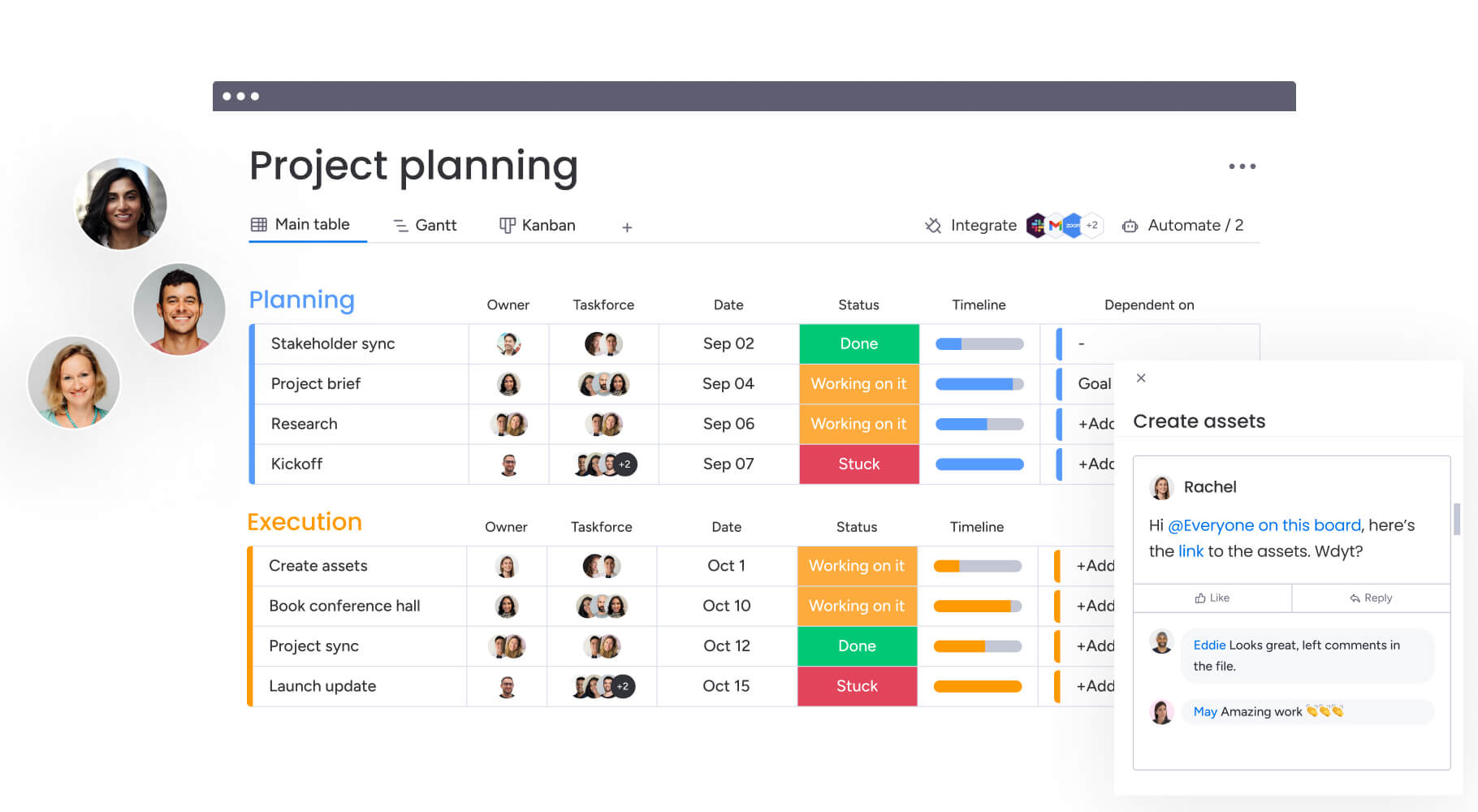
Monitoring and controlling the project schedule
Schedule management isn’t a one-and-done thing. If you want to keep your team on track, you need to continuously track the actual actual progress of the project against the baseline, identifying any deviations.
Regular updates and status reports can help the whole team stay informed about the project’s health, spot potential risks or delays, and make informed decisions to keep the project on track.
Keeping a close eye on your schedule won’t only help keep your project on time. It also gives you the opportunity to optimize resource allocation. For instance, if you notice one team member is falling behind, it might be a good idea to reassign some of their tasks to another colleague so they can catch up.
It’s easy to keep track of your projects, milestones, and deadlines in monday.com. Don’t let your projects fall behind – check it out today!
Get startedDealing with schedule delays and changes
Just 63% of projects are delivered on time (and that number drops to 39% for organizations with low-maturity project management functions.)
Getting schedule management right as a project manager comes down to responding effectively when things go wrong. If you spot that you’ve gone off-course from your schedule baseline, here’s what to do:
Identify the root cause: Start by figuring out what caused the delay. This can help prevent the same issue from coming up again later.
Assess the impact: How much is this delay going to matter? Some delays can have a major impact on meeting milestones and deadlines, and some won’t matter too much.
Be transparent: Change is normal, and we all know that problems happen. Hiding the delay will make things worse. Instead, keep all your stakeholders informed about any delays, so they can adjust their plans accordingly.
Update your schedule: Talk to your project team to make a new, updated schedule based on the new information. Do you need to skip particular tasks? Do you need more resources? Now’s your chance to bring things back on track.
Document changes and decisions: Write down what happened, why it happened, and how you responded. This will be helpful for future projects, and also keeps everyone accountable.
Learn from your mistakes: Once you’ve responded to the delay, make sure you talk it through with the project team so you’ll do better next time.
How to keep your project on schedule with monday work management
The main project schedule management tool you’ll need is a platform to create, share, and host your project schedule management plan.
A few years ago, project managers relied on tools like Excel sheets and Gantt charts to manage their project schedules. But those tools now seem old-fashioned.
For starters, they aren’t great for communicating with your project team. If (or when!) something gets delayed, you’ll have to manually inform everyone involved.
Nowadays, there’s a better — and smarter — way. With a combination of AI, collaboration features, and proven processes, monday work management can make the job of scheduling a project way easier.
Instead of calculating your critical path manually or designing a Gantt chart on Excel, the right software can automate those tasks for you, so you focus on what really matters.
Here are a few ways you can use monday work management for project schedule management:
Board views
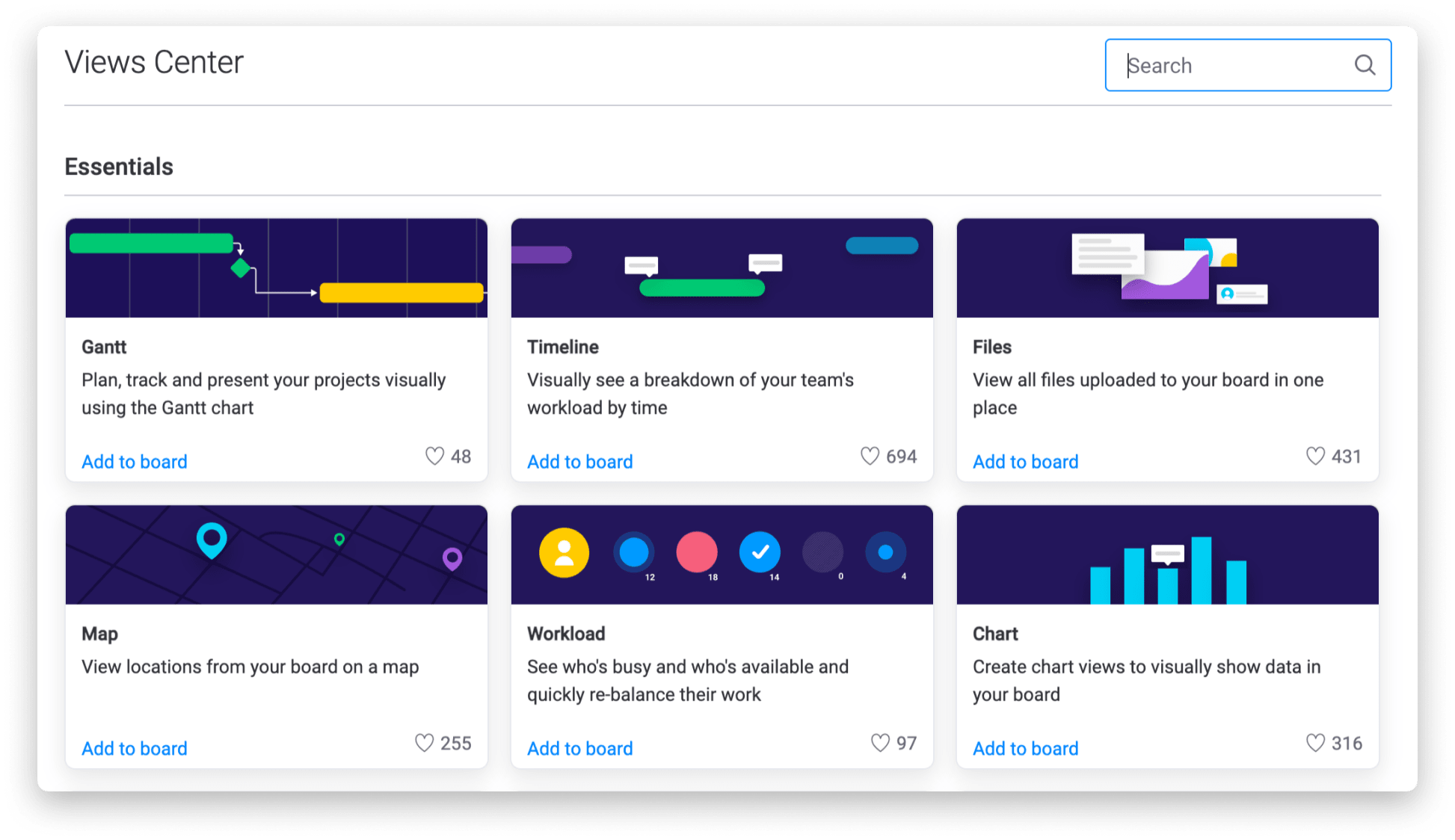
Board views allow you to visualize your project from many different perspectives and angles in just a couple of clicks. This way, you can analyze the data that’s most relevant to you.
Let’s break some of them down:
- Gantt chart: visually represents the timeline of project tasks and their dependencies, allowing you to monitor task progress, identify bottlenecks, and manage your project schedule efficiently.
- Workload: helps you oversee who’s doing what at every stage of the project and visualize the distribution of your work.
- Timeline: gives you a visual representation of dates and the project timeline as a whole.
- Calendar: allows you to visualize all your tasks, activities, and deadlines in the form of a calendar.
To get a full description of all of monday.com’s views, we suggest you read this guide.
Real-time dashboards
Dashboards let you instantly know where work stands, track project completion, and manage resources. This enables you to quickly identify deviations, delays, or a lack of resources, so you can react promptly. Dashboards also promote transparency, collaboration, and alignment among team members, fostering a proactive approach to project schedule management.

Automated updates
Keep everyone on the same page and notify the whole team of changes to the project schedule management plan with automated updates. Easily collaborate across your organization and with external stakeholders and customers.
Best practices for successful schedule management
Here are three expert tips for managing your project schedule management plan more effectively:
1. Define clear and measurable milestones
37% of projects fail due to the lack of defined project objectives and milestones, according to the Project Management Institute (PMI). To keep your project on schedule, set clear, easy-to-understand targets that your team can work towards.
2. Regularly track and communicate progress
More than half of all projects fail because of a “breakdown in communications.” Use project management software to make it easy to update your team and stakeholders, and take a proactive approach to notifying people about delays and bottlenecks.
3. Take project management seriously
Organizations that don’t integrate project management into their strategies will see their outright project failure rate increase by a factor of 2/3. Instead of scheduling projects on the fly, using a systematic approach to project management, coupled with an easy-to-use project management solution like monday.com, can make a huge difference to your schedule management.
Use one platform for better teamwork, and experience streamlined project scheduling
Whether you want to schedule personal projects or manage large, complex initiatives for your project team, now you have the information to start on solid ground.
If you’re trying to maximize your efforts, save time, and save yourself from unnecessary headaches, monday work management will make your job much easier.
 Get started
Get started 
